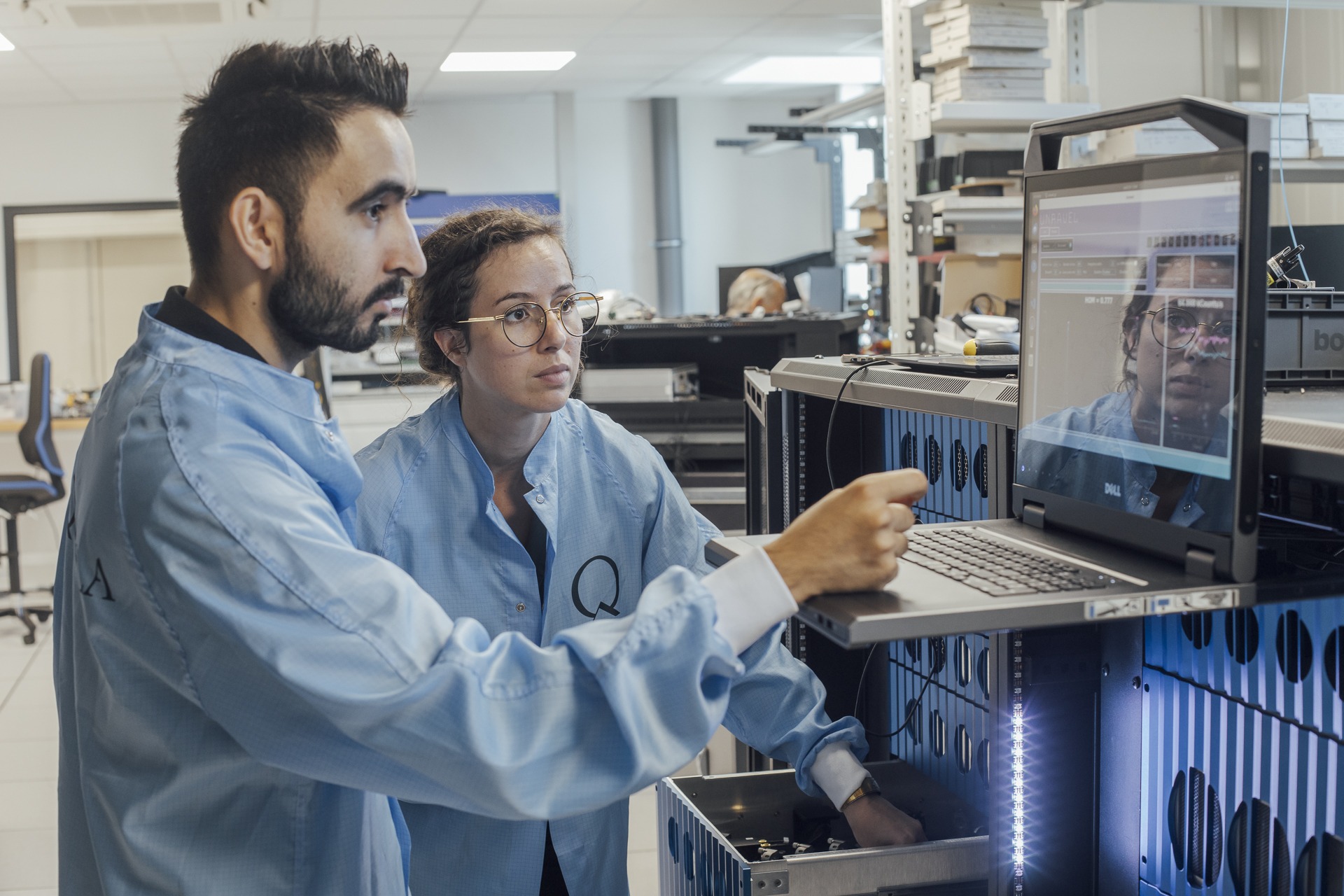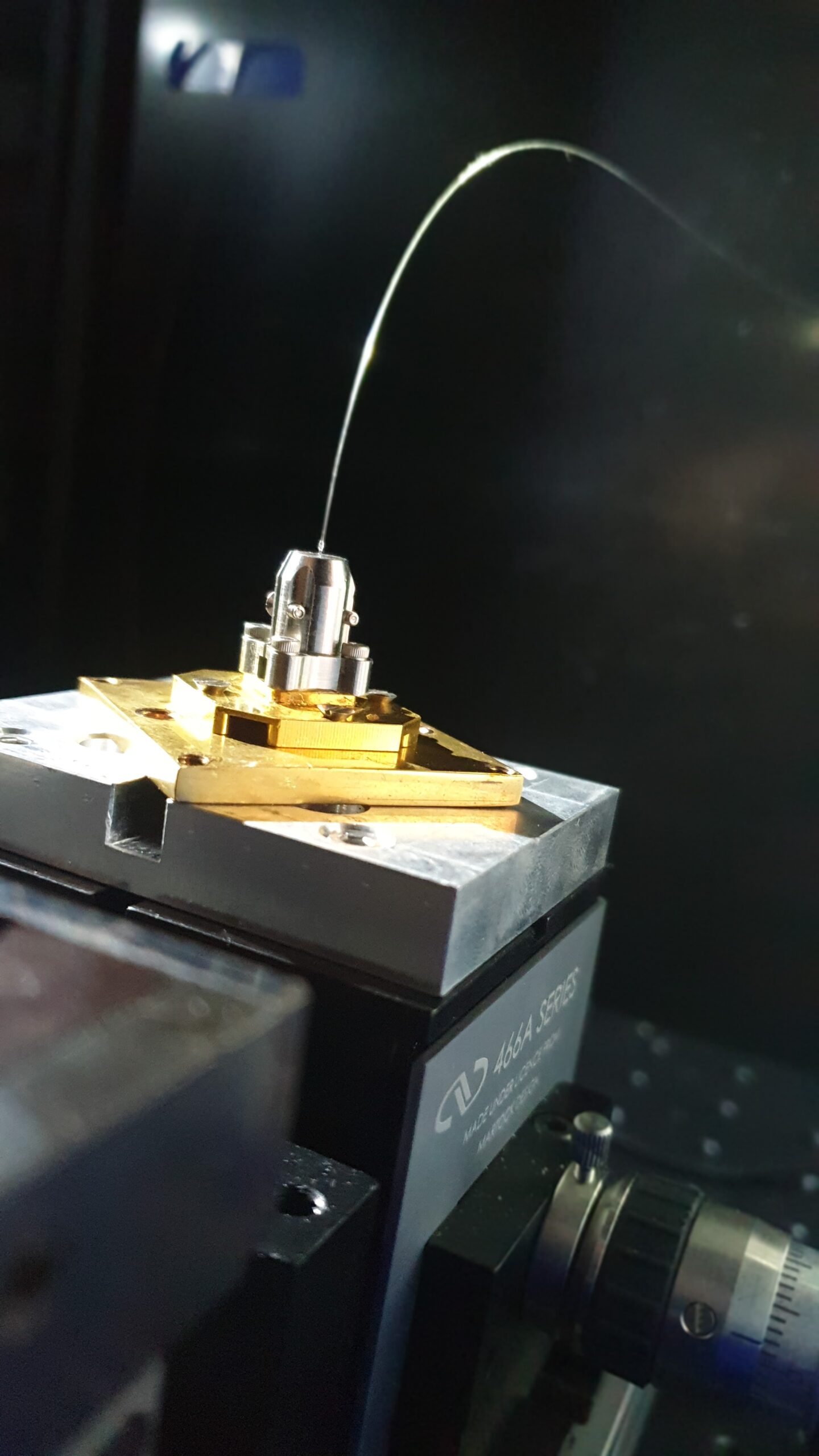Quantum computing is at the forefront of technology, with the potential to transform how we process information. This emerging field leverages quantum phenomena such as quantum superposition and entanglement to accomplish computational tasks at unprecedented speeds. Among the different strategies for achieving quantum computing, photonic quantum computing is a particularly bright star.
Photonic quantum computing uses light particles — photons — as the carrier quantum information. This approach has many benefits ; photons are stable, they have modest cooling requirements and they are scalable.
One method for encoding information in photonic quantum computing is ‘dual-rail encoding’. In dual rail encoding a pair of tracks form a qubit where the logical (1) is encoded in the photon traveling in the lower rail and the logical(0) is encoded in the photon traveling in the upper rail. This reliable encoding method is widely used in the photonic world. More details can be found here.
In a significant leap forward in this field, we at Quandela have developed Ascella1, a general-purpose single-photon-based quantum computing platform. Ascella is a quantum computer that uses a highly efficient quantum dot single photon source, which functions much like a miniature box that produces single photons on-demand which then go into its universal interferometer to perform the computation and subsequently are detected at the output for processing. More details about single photon sources here.
To compensate for hardware errors, Ascella uses a machine-learned transpilation process. Transpilation is the process of rewriting a given input circuit to match the topology of a specific quantum device. Additionally, it features a full software stack that enables remote control of the device, opening up opportunities for a range of computational tasks through logic gates or direct photonic operations.
At Quandela we have successfully demonstrated high-fidelity one-, two-, and three-qubit gates, implemented a complex quantum algorithm to calculate the ground-state energy of the hydrogen molecule and even developed a photon-based quantum neural network. Notably, Ascella achieved the generation of a unique type of quantum entanglement involving three photons — heralded 3-photon entanglement. This achievement is a critical milestone toward ‘measurement-based quantum computing’ a promising pathway to scale up quantum computers (*).
1. Diving Into Ascella’s Architecture
At its core, Ascella is a unique piece of technology that uses light to perform complex calculations. Its hardware is made up of several key components. Firstly, there is the single-photon source which produces the photons on demand. This source emits photons into a fiber which then sends the photons on their journey through the system. The system contains a device called a demultiplexer, which is responsible for splitting the stream of photons into separate streams. So it feeds the chip 6 photons that arrive at the same time. Secondly there is the unitary matrix in the universal interferometer which determines the evolution of the photons and finally detectors (SNSPD) at the outputs.

Peering into Ascella’s Operational Mechanism
Quantum interference is what enables Ascella’s operations. At the heart of the system is an integrated circuit, containing a multitude of voltage-controlled phase shifters and beamsplitters. This circuit can be programmed to perform a variety of tasks, transforming the photons’ states as they move through the circuit. These photons are then detected and recorded, creating the output data from Ascella.
Stability and Performance
Just like a well-oiled machine, Ascella needs to perform consistently over time. To ensure this, key performance metrics are monitored and the system undergoes automatic hourly optimizations. This commitment to performance maintenance allows Ascella to remain stable and high performing for weeks on end, an essential quality for any computing platform and especially for the demanding realm of quantum computing.
Ascella’s User Interface
Ease of use is another important aspect of Ascella’s design. Users can interact with Ascella remotely using the open-source Perceval framework. This allows users to send tasks, such as specifying a certain pattern for the photonic circuit or requesting a specific transformation on an input state, which could contain anywhere from one to six photons. The results are then sent back to the user.

PC = Photonic circuit, GB = Gate based, U= Unitary, ɸ= Phase shifts, V= Voltages
Ascella represents an exciting stride towards scalable quantum computing. It operates a record-breaking number of single photons on a chip and its robust capabilities combined with a user-friendly interface making it a promising player in the noisy intermediate-scale quantum (NISQ) computing era.
2. Quantum Chemistry: Ascella’s Variational Quantum Eigensolver
Understanding the behavior of molecules is critical in fields like chemistry and medicine. However, simulating molecular behavior can be incredibly complex for classical computers, especially when it comes to quantum phenomena. Ascella, Quandela’s photonic quantum computer takes advantage of the Variational Quantum Eigensolver (VQE), a tool for quantum chemistry.
The VQE is a hybrid quantum-classical algorithm that can estimate the ground state energy of a molecule, providing insight into its lowest energy configuration. This ground state knowledge is crucial as it can help predict how a molecule will react in a chemical reaction, which in turn, can lead to new drug developments or more efficient materials for energy production. In our case the VQE algorithm was used on a H2 molecule with the following ansatz.

This is where the “variational” part of VQE comes in: it iteratively varies the parameters of the wavefunction to find the one that gives the lowest energy. This is done in a feedback loop, where the quantum computer calculates the expectation value, then a classical computer updates the parameters and directs the quantum system to recalculate based on these new parameters.

In practice, Ascella’s VQE consistently converges to the theoretical energy eigenvalue within 50 to 100 iterations, regardless of the initial random parameters or bond length. In tests, the algorithm achieved chemical accuracy — an error of only ±0.0016 Hartree, a unit of energy in the atomic scale — with a success probability of 93%. These significant improvements can be attributed to the high-quality single-photon sources and advanced control of the photonic chip.
3. Ascella’s Quantum Neural network/Variational quantum algorithm for classification:
Quandela has successfully constructed and trained a quantum neural network (QNN) for a supervised learning classification task using our advanced quantum computing platform, Ascella. In designing our approach, we utilized a variational quantum algorithm (VQA) for constructing the QNN. Similar to classical neural networks, where interconnected neurons are represented by numerical weights and biases, a QNN consists of qubits manipulated by quantum gates. The parameters of these quantum gates, analogous to the weights and biases in classical networks, are adjusted during the learning process to minimise some cost function.
The VQA represents a hybrid quantum-classical strategy, where the quantum device prepares a quantum state dependent on a set of parameters, and the classical device estimates a value for that state.

We developed our quantum algorithm with a photonic ansatz. This ansatz was designed directly on Ascella by using beam splitters and phase shifters. We then applied this methodology to the Iris dataset, which contains measurements such as petal and sepal sizes from different species of Iris flowers. The task was to predict the Iris species based on these measurements.

This experiment constitutes an application of a variational quantum classifier with single photons, a notable achievement. This process yielded an accuracy of 92% on the training set and an even higher 95% on the test set after about 15 iterations.
In summary, our represents an important step in quantum machine learning. By successfully training a QNN on a classic machine learning problem, we have demonstrated the potential for quantum computers to process complex data efficiently. This successful application of a variational quantum classifier with single photons heralds exciting possibilities for the future of quantum computing and machine learning.
4. A quantum over classical computational task: Boson sampling
In a step forward for our quantum computing approach, we have conducted an experiment in Boson Sampling with six single photons.
Let’s explain what this means, starting with Boson Sampling. Think of this as trying to predict how a bunch of photons (particles of light) will distribute themselves after passing through a complex network of mirrors and splitters. The classical version, a Galton board might help visualize this with a ball moving between pegs and creating like such.

However, the real quantum task is much more complex. Unlike balls on a Galton board, photons interfere with each other in a quantum mechanical way, leading to a highly complex probability distribution of the output states. Simulating this process with classical computers is incredibly difficult, but a quantum computer, mimicking the physical processes involved, can solve this problem naturally.
Our experiment involves performing Boson Sampling for a record number of six photons with a fully reconfigurable interferometer. An interferometer is a device used to split and recombine beams of light, creating an interference pattern that can be measured.
In the experiment, we measured the occurrences of photon coincidences (when multiple photons are detected at the same time) for up to six photons. We then compared the observed distribution of photon outputs to the ideal distribution predicted by our model.
This accomplishment is a significant stride and step forward for quantum computing, we have conducted an experiment in Boson Sampling with six single photons with high fidelity, demonstrating this quantum-over-classical computational task.
5. Expanding Ascella’s Quantum Computing Capabilities
We are pushing the boundaries of our quantum computing capabilities. As of now, we’ve achieved an operation speed that is quite impressive. And we believe this speed can be further improved by optimizing each component of our system.
One such component is the single-photon source, which essentially generates the tiny particles of light, or photons, that carry information in this system. Currently, it’s operating at about 55% efficiency.2 With advancements in technology, we believe that we can increase this efficiency by up to 96%. This means the platform will generate almost twice as many usable photons as it currently does, a significant increase in data processing potential.
Additionally, we have plans to increase the size of the interferometer on the chip we’re using. This mean the chip can process more information simultaneously, which means that we can run tests on larger molecules than H2 and more sophisticated algorithms in general.
An essential part of this exploration involves GHZ states. These are specific entangled configurations in a quantum system involving three or more particles. Creating and controlling these GHZ states is a significant milestone in quantum computing. It represents our growing ability to manipulate complex quantum entanglements involving multiple particles, a crucial aspect of measurement-based quantum computing (MBQC). Even more impressively, on the Ascella project we managed to generate these GHZ states predictably or in a “heralded” way. That means we could not only anticipate the creation of these states but also confirm when they occurred.
The successful implementation of these heralded entanglement schemes opens the door to fault-tolerant quantum computing. It’s an exciting time for quantum computing, and we’re thrilled to be at the forefront with Ascella!
References:
- Nicolas Maring, Andreas Fyrillas, Mathias Pont, Edouard Ivanov, Petr Stepanov et al :
A general-purpose single-photon-based quantum computing platform https://arxiv.org/abs/2306.00874 ↩︎ - A single photon source that operates at 100% efficiency would emit a single photon each time it is triggered. At 55% efficiency it would emit a single photon each time it is triggered 55% of the time. ↩︎




